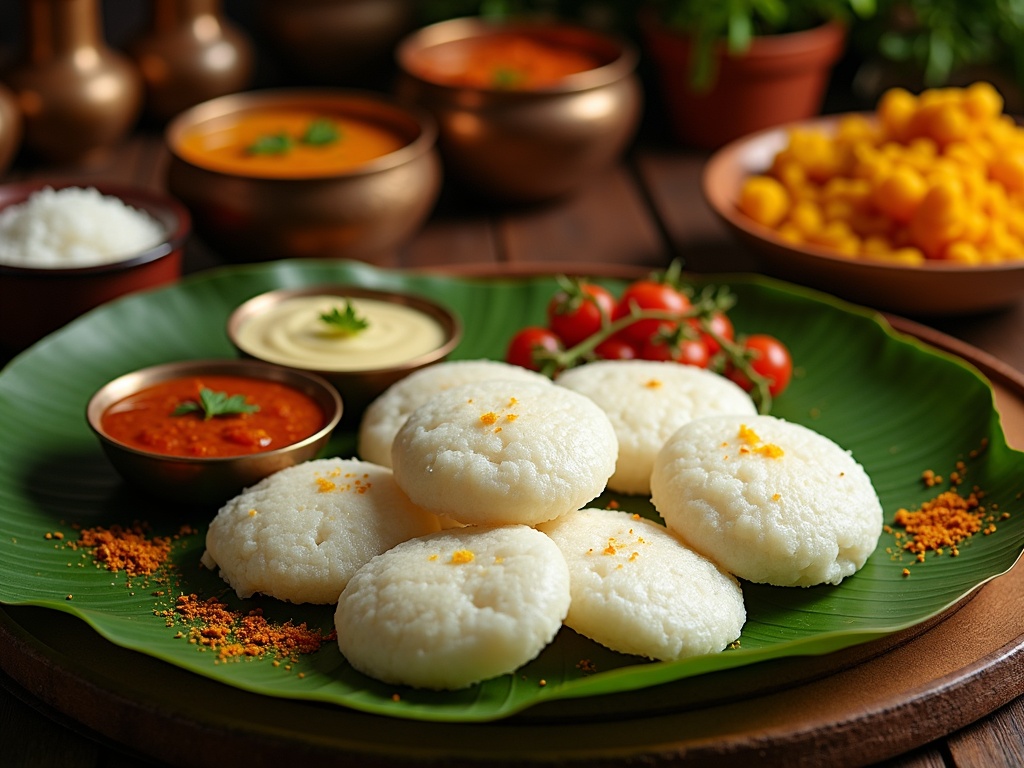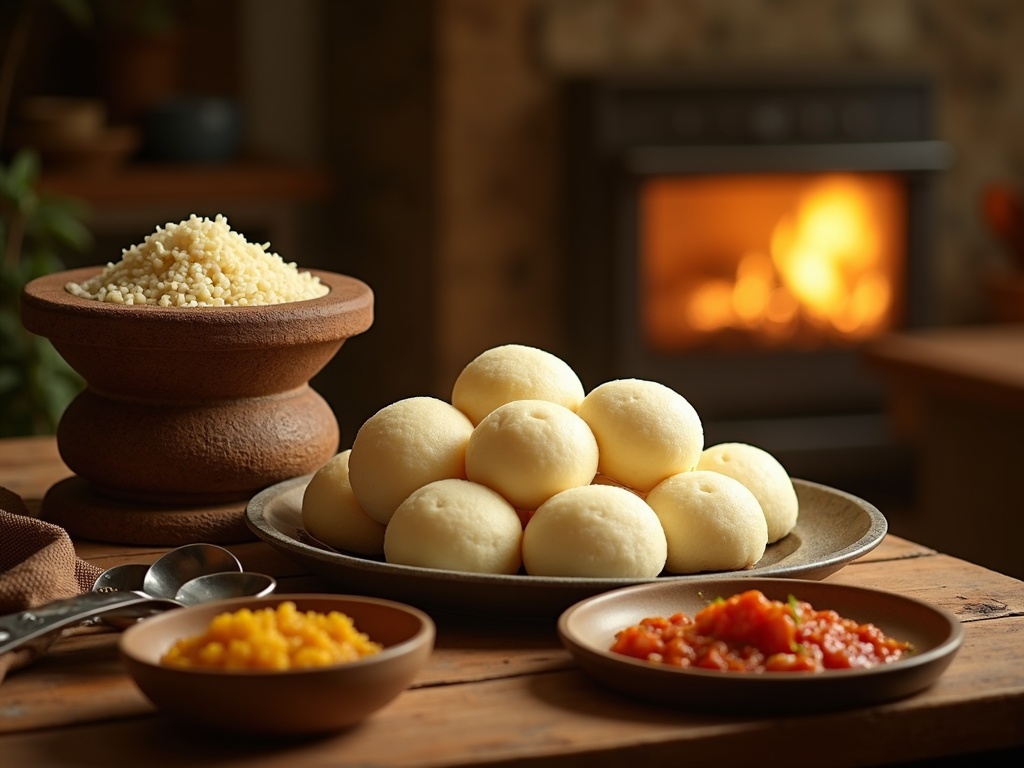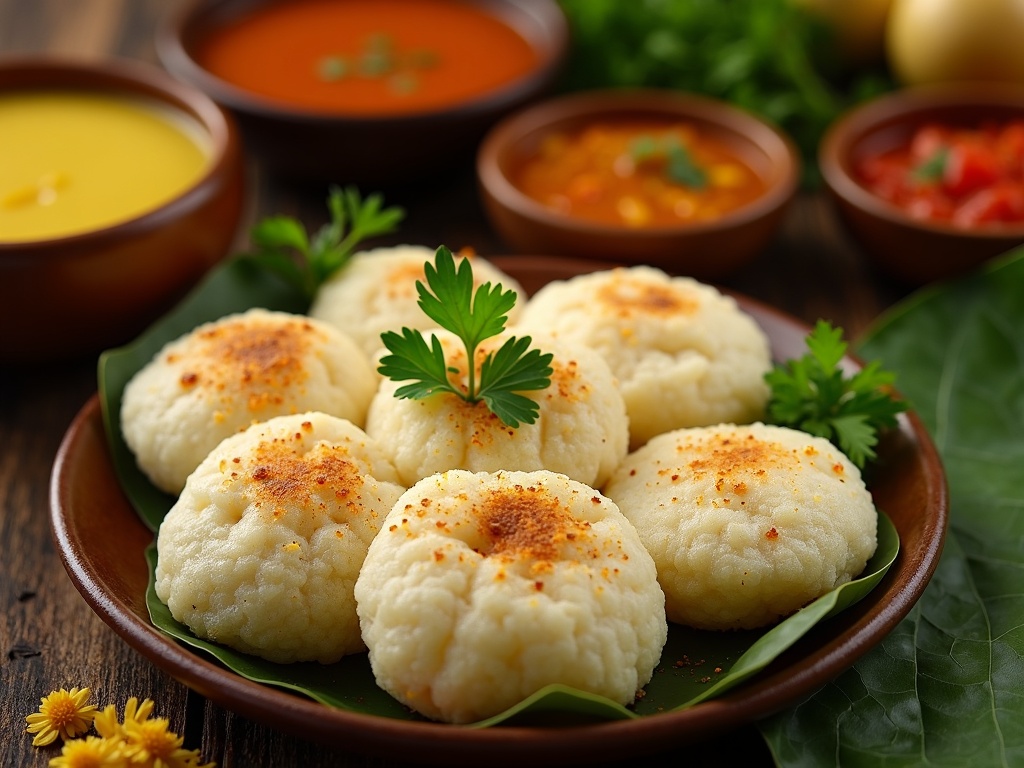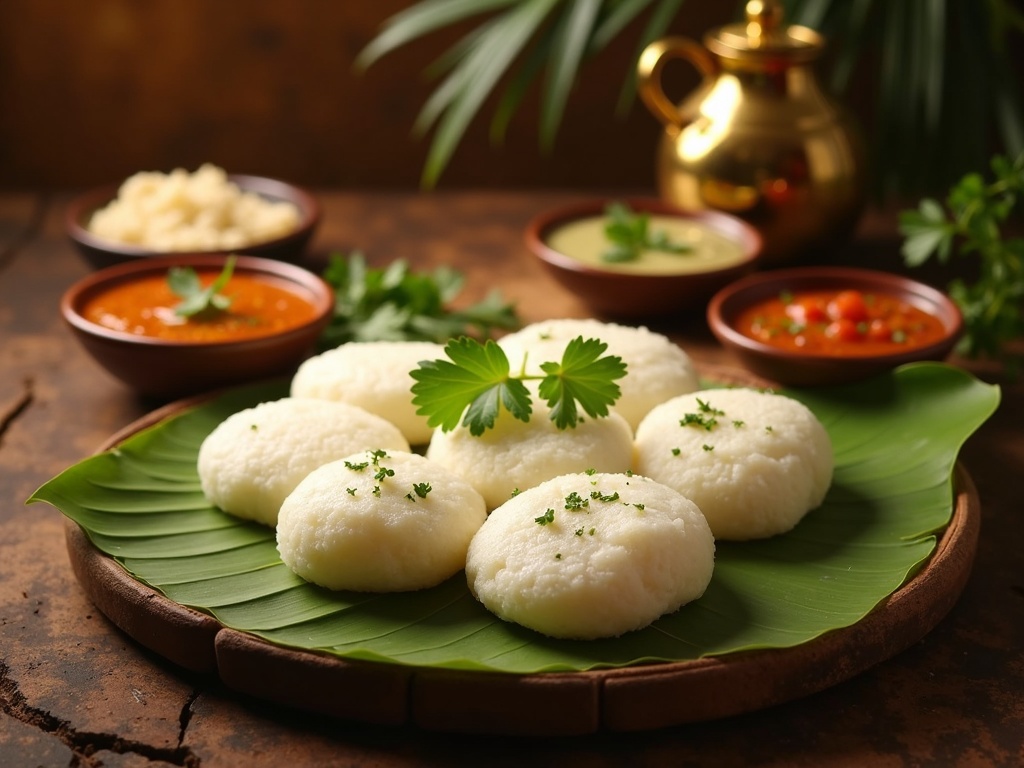Idli recipe, a traditional South Indian steamed rice cake made from fermented batter, com recipebines simplicity with remarkable nutritional benefits to create the perfect healthy breakfast option. Its ancient preparation method involving the fermentation of rice and lentils not only enhances flavor but also improves digestibility and increases the bioavailability of nutrients, making it a globally recognized culinary treasure.
Find In This Article
Key Takeaways
- Idli is naturally gluten-free, low in calories (about 39 per piece), and offers probiotic benefits through its fermentation process.
- The basic idli recipe requires just a few ingredients: rice, urad dal (black gram), fenugreek seeds, salt, and water.
- Proper fermentation (8-12 hours) and steaming techniques are crucial for achieving the signature soft, fluffy texture.
- Idli pairs traditionally with accompaniments like sambar, coconut chutney, and tomato chutney for a complete, balanced meal.
- Beyond its South Indian origins, idli has gained global popularity for its versatility, nutritional profile, and suitability for various dietary preferences.
Why Idli is a Perfect Healthy Breakfast
Idli is a quintessential South Indian breakfast dish that’s gained global popularity for its simplicity and nutritional benefits. This steamed cake, crafted from fermented rice and lentil batter, offers a powerful health punch while satisfying morning hunger pangs. I’ve found idlis to be an excellent way to start my day because they’re incredibly light yet surprisingly filling.
Nutritional Powerhouse with Ancient Roots
The humble idli boasts an impressive nutritional profile that makes it stand out among breakfast options. With just 39 calories per piece, these fluffy white discs are naturally gluten-free, making them suitable for those with celiac disease or gluten sensitivity. I often recommend idlis to friends looking to maintain a balanced diet without sacrificing taste.
The origins of idli trace back to ancient Indian culinary traditions, where it held significant cultural importance. What began as a staple in South Indian households has now transcended regional boundaries to become a beloved dish across India and beyond. Its preparation method hasn’t changed much over centuries, which speaks to its perfect formula.
The fermentation process is what truly sets idli apart from other breakfast options. When the rice and lentil batter ferments overnight, it creates beneficial bacteria that enhance the protein content and improve digestibility. This natural process breaks down complex carbohydrates and proteins, making nutrients more accessible to your body.
For a complete breakfast experience, I like to pair idlis with these accompaniments:
- Spicy sambar for added protein and vegetables
- Fresh coconut chutney that delivers healthy fats and flavor
- Tangy tomato chutney for a vitamin C boost
- A sprinkle of gunpowder (spice mix) with a drizzle of ghee for extra satisfaction
The versatility of idli extends beyond breakfast. I’ve found them to be excellent snacks throughout the day, and they store well in the refrigerator for up to two days. Their neutral flavor profile makes them adaptable to various chutneys and accompaniments, allowing for creative meal planning.
What makes idli particularly special is its place as a traditional breakfast staple in South Indian households. Children grow up eating these steamed cakes, often served with a variety of sides that add both nutritional value and flavor. The dish exemplifies how traditional food wisdom often aligns perfectly with modern nutritional science.
For those new to making idlis at home, the process might seem detailed but becomes second nature with practice. The key lies in proper fermentation and steaming techniques. The effort pays off when you bite into a soft, spongy idli that practically melts in your mouth while providing sustained energy for hours.
When considering healthful breakfast options that won’t spike blood sugar or leave you hungry shortly after, idli stands as a brilliant choice that has stood the test of time. Its low calorie count, combined with the probiotic benefits of fermentation, creates a breakfast option that supports gut health while providing essential nutrients to kickstart your day.

Essential Ingredients for Perfect Idli
Making perfect idli starts with selecting the right ingredients. I’ve found that using quality components and proper proportions creates that signature fluffy texture we all crave in this South Indian staple.
The Core Components
The foundation of any good idli begins with just a handful of simple ingredients:
- 2 cups short-grain or parboiled rice – This provides the structure of the idli
- 1 cup split urad dal (black gram), soaked for 4-6 hours – This contributes the fluffiness
- 1 teaspoon fenugreek seeds – A critical fermentation aid
- 1 teaspoon salt – Enhances flavor and helps with fermentation
- Water as needed – For achieving the right batter consistency
The type of rice you choose significantly impacts your idli’s texture. I prefer using idli rice varieties or parboiled rice, which create that perfect softness without becoming too sticky or dense.
Urad dal deserves special attention—it’s what gives idli its characteristic sponginess. I’ve found that soaking it properly for 4-6 hours is non-negotiable for achieving that perfect fermentation.
Fenugreek seeds might seem like a minor addition, but they’re actually crucial. Beyond helping with fermentation, they add subtle flavor notes and bring valuable health benefits. They contain compounds that aid digestion, making them a perfect complement to a hearty sambar served alongside.
Getting the water proportion right is something that comes with practice. I start with less and add gradually while grinding to achieve a batter that’s neither too thick nor too runny—similar to pancake batter.
When served fresh, these idlis pair beautifully with coconut chutney or spicy tomato chutney for a complete breakfast or light dinner option.
The beauty of idli lies in its simplicity. With just these few ingredients and some patience for fermentation, I can create a nutritious, easily digestible meal that’s satisfying and light. The fermentation process not only improves flavor but also increases the bioavailability of nutrients, making idli both delicious and nourishing.
The Secret to Soft and Fluffy Idlis
Perfect idlis have a cloud-like texture that can be challenging to achieve. I’ve spent years perfecting my technique, and I’m excited to share the key steps that make all the difference.
The Preparation Process
The journey to pillowy idlis begins with proper soaking. I always soak idli rice and urad dal separately for 4-6 hours in plenty of water. This separation is crucial because rice and dal soften at different rates. After soaking, the ingredients need to be ground to the right consistency. I use a wet stone grinder for this task as it creates less heat during grinding, preserving the natural fermentation capabilities of the batter.
When grinding, I start with the urad dal, processing it until it’s light and fluffy. The texture should be smooth but not pasty – you’ll know it’s right when you can drop a small amount in water and it floats. Rice should be ground next until it has a slightly grainy texture, similar to fine semolina.
After grinding, I combine both batters with salt and mix them thoroughly by hand. The mixture should feel airy and have a medium consistency – not too thick or thin. This is where I might add a pinch of fenugreek seeds for improved fermentation.
Mastering the Fermentation
Fermentation is where the magic happens. The combined batter needs 8-12 hours in a warm environment, ideally at 30-35°C (86-95°F). Here are factors that affect fermentation quality:
- Climate conditions: Warmer regions need less time; colder regions might require 12+ hours
- Container material: Clay or stainless steel pots enhance fermentation compared to plastic
- Starter culture: Adding a spoonful of previous day’s batter speeds up the process
- Water quality: Filtered water works better than chlorinated tap water
I’ve found that placing the batter in a turned-off oven with just the light on creates an ideal environment. The batter should rise to nearly double its volume and develop small bubbles on the surface.
For steaming, I grease idli molds lightly and fill them three-quarters full with the fermented batter. Steaming for 10-12 minutes yields perfectly cooked idlis. I let them rest for 5 minutes before gently removing them with a wet spoon.
For a complete meal, I serve my idlis with flavorful sambar and tangy tomato chutney. The combination creates a balanced breakfast that’s both nutritious and satisfying.

Traditional Serving Suggestions and Health Benefits
Idli, the fluffy steamed rice cakes, are truly versatile when it comes to pairing them with the right accompaniments. I’ve found that the classic combination of idli with freshly made coconut chutney creates a perfect balance of flavors – the mild idli complemented by the rich, slightly sweet chutney.
Classic Pairings
For a complete South Indian breakfast experience, I pair my idlis with:
- Sambar, a tangy lentil soup with vegetables that adds both flavor and nutrition
- Spicy tomato chutney for those who prefer a tangier kick
- A light sprinkle of fresh coriander leaves as a garnish adds a fresh aroma
- Milagai podi (spiced powder) mixed with a dash of oil for an extra punch
The beauty of these combinations is how they transform simple idlis into a complete meal. The sambar provides protein from lentils while the idli offers easy-to-digest carbohydrates.
Nutritional Benefits
Idlis stand out as a nutritional powerhouse in the world of breakfast foods. The fermentation process used in making idlis increases bioavailability of proteins and enhances vitamin B content. I’ve noticed that many health-conscious individuals favor idlis because they’re:
- Steamed, not fried, making them naturally low in fat
- Fermented, which improves digestibility and gut health
- Filling yet light on the stomach
- Suitable for various dietary restrictions
For enhanced nutrition, I often prepare ragi idli by incorporating finger millet into the batter. This variation adds calcium, iron, and fiber to an already healthy dish.
Idlis have gained popularity among those following vegan diets since they contain no animal products. They’re also favored by those with gluten sensitivities as traditional idlis use rice and urad dal rather than wheat.
For a complete meal with balanced nutrition, I sometimes serve idlis with a side of vegetable pulao for dinner. The combination works surprisingly well, especially when I’m looking for something substantial yet easy to digest.
When hosting guests with varied dietary preferences, I find that a plate of hot idlis with various chutneys and a bowl of sambar satisfies almost everyone at the table, making it my go-to option for brunches and casual gatherings.

Cultural Impact and Global Recognition
Idli has cemented its place not just in South Indian kitchens but across global culinary landscapes. This humble steamed rice cake has journeyed far beyond its origins, carrying with it the essence of Indian hospitality and nourishment.
Celebration and Tradition
In South India, idli transcends being merely a breakfast item – it’s an integral part of cultural identity. During festivals like Pongal and Diwali, idli features prominently on celebration menus, often served on banana leaves for an authentic touch. Family gatherings typically include idli as a staple, with multiple generations coming together to prepare and enjoy this communal food.
I’ve noticed that even as families move away from their hometowns, the tradition of making idli brings a sense of connection to roots and heritage. The process of grinding the batter and the distinct aroma of steaming idlis often evokes childhood memories for many South Indians.
Global Appreciation
The international appeal of idli has grown exponentially in recent years. What was once considered an exotic dish is now celebrated for its:
- Nutritional profile as a fermented, probiotic-rich food
- Gluten-free and vegan-friendly composition
- Versatility as a canvas for various accompaniments
- Light, digestible nature that appeals to health-conscious diners
From New York to Tokyo, idli with sambar appears on menus of upscale restaurants and street food stalls alike. The dish has been adapted to suit local tastes while maintaining its core characteristics – in California, you might find idlis served with avocado, while European cafés pair them with local cheese spreads.
Food enthusiasts globally have embraced idli’s versatility, creating fusion dishes like idli pizzas or idli sandwiches. This adaptability has helped it cross cultural boundaries while retaining its authentic charm.
What makes idli particularly special is its inclusivity – it fits seamlessly into various dietary preferences, from keto adaptations using almond flour to protein-enriched versions with added lentils. The basic recipe welcomes personalization with add-ins like spinach, carrots, or coconut chutney as an accompaniment.
As interest in gut health and fermented foods continues to grow, idli’s ancient wisdom of fermentation before consumption positions it perfectly in contemporary nutritional conversations. Its sustainability credentials – requiring minimal resources to produce – also align with modern ecological concerns.
Sources:
The Ultimate Guide to Indian Cooking by Aditi Malhotra
Indian Cuisine: A Historical Overview by K. Anand
The Health Benefits of Fermented Foods by Emily Patel in Health Magazine
Culinary Traditions of South India by Rajiv Sethi

